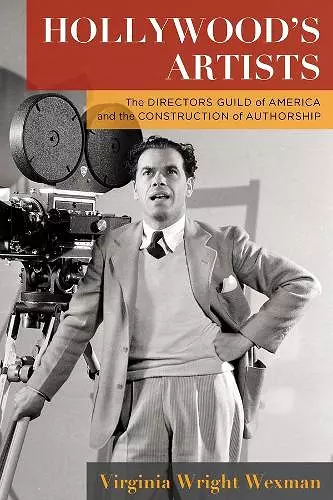Hollywood's Artists
The Directors Guild of America and the Construction of Authorship
Format:Hardback
Publisher:Columbia University Press
Published:26th Jun '20
Currently unavailable, and unfortunately no date known when it will be back

Today, the director is considered the leading artistic force behind a film. The production of a Hollywood movie requires the labor of many people, from screenwriters and editors to cinematographers and boom operators, but the director as author of the film overshadows them all. How did this concept of the director become so deeply ingrained in our understanding of cinema?
In Hollywood’s Artists, Virginia Wright Wexman offers a groundbreaking history of how movie directors became cinematic auteurs that reveals and pinpoints the influence of the Directors Guild of America (DGA). Guided by Frank Capra’s mantra “one man, one film,” the Guild has portrayed its director-members as the creators responsible for turning Hollywood entertainment into cinematic art. Wexman details how the DGA differentiated itself from other industry unions, focusing on issues of status and creative control as opposed to bread-and-butter concerns like wages and working conditions. She also traces the Guild’s struggle for creative and legal power, exploring subjects from the language of on-screen credits to the House Un-American Activities Committee’s investigations of the movie industry. Wexman emphasizes the gendered nature of images of the great director, demonstrating how the DGA promoted the idea of the director as a masculine hero. Drawing on a broad array of archival sources, interviews, and theoretical and sociological insight, Hollywood’s Artists sheds new light on the ways in which the Directors Guild of America has shaped the role and image of directors both within the Hollywood system and in the culture at large.
Virginia Wright Wexman’s original, fine-grained study of the Directors’ Guild of America shows us how that organization helped shape the idea of the film director as author, how it managed political tensions within Hollywood, and how it negotiated major changes in the industry. Based on extensive research, this is a revealing and highly important contribution to U.S. film history. -- James Naremore, Indiana University
Hollywood’s Artists is a groundbreaking study of the Directors Guild of America—viewing it not primarily as a traditional union, but as an organization that has fought for the recognition of its members as artists. Wexman provides a well-researched history of earlier organizations leading up to the formation of the DGA, the cultural context for its claims of artistry (including European traditions and the auteur theory), the effects of the rise of television, as well as a discussion of a controversial moment in its history during the McCarthy era, the HUAC hearings, and the persecution of the “Hollywood Ten.” Furthermore, she examines the notion of the director as authority figure (which requires “charisma”) as well as the legal battles engaged in by the organization. Finally, Wexman explores new challenges to film directors in the current era involving the ascendancy of digital effects and streaming services, as well as the globalization of the industry. In sum, a thorough and masterful study. -- Lucy Fischer, author of Cinema by Design: Art Nouveau, Modernism, and Film History
This book fills a significant void in film history and offers an original and important argument about the role of the director in the ‘authorship’ of Hollywood films. -- Tom Schatz, University of Texas at Austin
[A] concise and lucid history of how the Directors Guild focused upon the authorship of film. * Film Quarterly *
Introduces academic audiences to the nuances of labor, law, and DGA politics by providing extensive sources from practitioners and adding context to famous moments in DGA history . . . Recommended. * Choice *
Wexman has written a perceptive and interesting account of the Guild’s development and its underlying values. * Film & History *
ISBN: 9780231195683
Dimensions: unknown
Weight: unknown
312 pages